
Pensacola is the westernmost city in the Florida Panhandle, and the county seat and only incorporated city of Escambia County, Florida, United States. At the 2020 United States census, the population was 54,312. Pensacola is the principal city of the Pensacola Metropolitan Area, which had an estimated 502,629 residents in 2019.

Araneta City, formerly and still commonly known as Araneta Center, is a 35-hectare (86-acre) transit oriented, commercial mixed-use development in Quezon City, Philippines. Situated in Barangay Socorro in Cubao, and at the intersection of two major roads, Epifanio de los Santos Avenue (EDSA) and Aurora Boulevard, the area offers retail, dining, entertainment, residential, office, lodging and parking facilities throughout the complex and hosts over 1 million people daily, due to its close proximity to transport terminals, including the railway stations of the MRT Line 3 and the LRT Line 2.

Canal Street is a major thoroughfare in the city of New Orleans. Forming the upriver boundary of the city's oldest neighborhood, the French Quarter or Vieux Carré, it served historically as the dividing line between the colonial-era (18th-century) city and the newer American Sector, today's Central Business District.
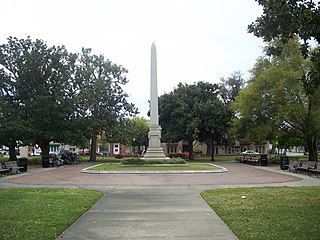
The Plaza Ferdinand VII is an outdoor garden and park in the Historic Pensacola Village area of downtown Pensacola, Florida. It is located on Palafox Street between Government and Zaragoza Streets. It was named after Ferdinand VII of Spain, the King of Spain between 1813 and 1833. A National Historic Landmark, it is the site of the formal transfer of Florida to United States jurisdiction in 1821.

The Pensacola metropolitan area is the metropolitan area centered on Pensacola, Florida. It is also known as the Pensacola-Ferry Pass-Brent Metropolitan Statistical Area, a metropolitan statistical area (MSA) used for statistical purposes by the United States Census Bureau and other agencies. The Pensacola Standard Metropolitan Statistical Area was first defined after the 1960 United States Census, with Pensacola as the principal city, and included Escambia and Santa Rosa counties. Ferry Pass and Brent, which are unincorporated census-designated places in Escambia County, were added as principal cities after the 2000 Census. The population of the MSA in the 2020 census was 511,502.
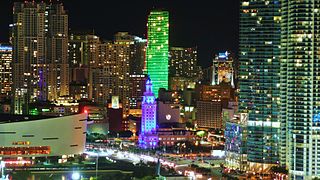
Downtown Miami is the urban city center of Miami, Florida. The city's greater downtown region consists of the Central Business District, Brickell, the Historic District, Government Center, the Arts & Entertainment District, and Park West. It is divided by the Miami River and is bordered by Midtown Miami's Edgewater and Wynwood sections to its north, Biscayne Bay to its east, the Health District and Overtown to its west, and Coconut Grove to its south.

Downtown Commons, formerly known as Sacramento Downtown Plaza, Westfield (Shoppingtown) Downtown Plaza and Downtown Plaza, is a two-level outdoor mixed-use entertainment and shopping complex operated by JMA Ventures, LLC, located along the alignment of K Street in downtown Sacramento, California, United States, near the State Capitol building. The complex is bordered by J Street to the north, L Street to the south, 7th Street to the east and 4th Street to the west. Downtown Commons' previous format was a mainly two-level outdoor shopping mall commonly known as Downtown Plaza, despite numerous official name changes over the years. The majority of the site has been redeveloped, centering on the Golden 1 Center, home of the NBA's Sacramento Kings. The section between 5th and 7th Streets was demolished in 2014 to make room for the Golden 1 Center, as well as The Sawyer, a 250-room boutique hotel operated by Kimpton Hotels immediately north of the arena site. The remaining standing section between 4th and 5th Streets was also redeveloped a few years later in association with the arena project.
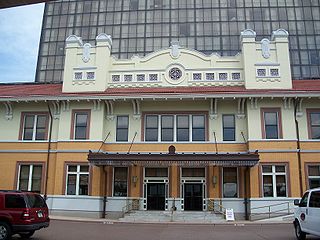
The Louisville and Nashville Passenger Station and Express Building is a historic Louisville and Nashville Railroad passenger train depot in Pensacola, Florida. It is located at 239 North Alcaniz Street.

The Saenger Theatre, also known as the Saenger Theater, is a historic theater in Pensacola, Florida. It is located at 118 South Palafox Place. On July 19, 1976, it was added to the U.S. National Register of Historic Places.

The Thiesen Building, built in 1901, is a historic site in Pensacola, Florida. It is located at 40 South Palafox Street. On December 13, 1979, it was added to the U.S. National Register of Historic Places.
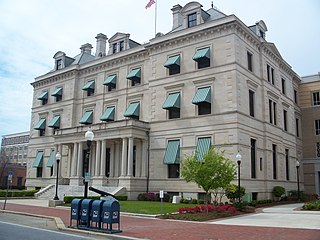
The U.S. Customs House and Post Office, also known as the Escambia County Courthouse, is a historic site in Pensacola, Florida. Built in 1887, it is located at 223 Palafox Place. On July 22, 1997, it was added to the U.S. National Register of Historic Places.
Cordova Mall, located in Pensacola, Florida, is the largest shopping center on the northwest Gulf Coast of Florida.

U.S. Route 29 in the State of Florida is the westernmost south-to-north U.S. route in the state. It runs 43.6 miles (70.2 km) from downtown Pensacola north to the Alabama state line entirely within Escambia County. US 29 runs as a four-lane highway through much of the panhandle, becoming six lanes through and near several towns. The highway's hidden state road designation is entirely State Road 95.

State Road 298, known locally as Lillian Highway, is a mostly east–west thoroughfare in Pensacola, Florida. It runs from its intersection with U.S. Highway 98 and Dog Track Road, skirting Perdido Bay on its way east to its terminus at the West Pensacola spur of SR 295. SR 298 passes under the mainline of SR 295 without an interchange. It serves as a major route through the communities of Myrtle Grove and West Pensacola.
The Louisville and Nashville Depot is an historic Louisville and Nashville Railroad depot located at 206 Henry Street in Milton, Santa Rosa County, Florida. It was built in 1909 on the site of the former Pensacola and Atlantic depot built in 1882 which burned down in 1907. In 1973, the station was closed, but partially restored with a 1976 Bicentennial grant.

Downtown Santa Ana (DTSA), also called Downtown Orange County, is the historic city center of Santa Ana and the county seat of Orange County, California. It is the institutional center for the city of Santa Ana as well as Orange County, a retail and business hub, and has in recent years developed rapidly as a regional cultural, entertainment and culinary center for Orange County.
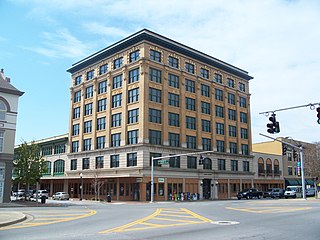
The Blount Building is an historic seven-story Chicago school style office building located at 3 West Garden St., SW corner of Palafox St., Pensacola, Escambia County, Florida. It was built by Charles Hill Turner in 1906-1907 for local attorney William Alexander Blount on the site of the three-story Blount-Watson Building, which had burned on Halloween night in 1905. The building features so-called Chicago windows and contains in its exterior the contain the three parts of a classical column, with the first and second floors being the base of the column, the third through sixth floors the shaft and the seventh floor the capital. The first floor exterior has been changed over the years reflect different retail needs, but the exterior of the upper floors remains intact.
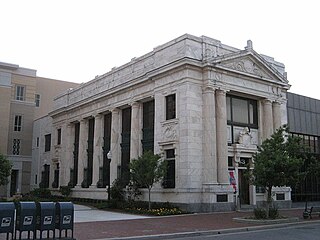
The First National Bank Building, also known as the Citizens and Peoples National Bank Building, is an historic two-story Classical Revival style building located at 213 South Palafox Street in Pensacola, Escambia County, Florida. Built in 1906-1908 by Charlie Hunter, it was designed by the New York architectural firm Mowbray and Uffinger. In 1989, the building was listed in A Guide to Florida's Historic Architecture, published by the University of Florida Press.

Downtown Rochester is the economic center of Rochester, New York, and the largest in Upstate New York, employing more than 50,000 people, and housing more than 6,000.

The Palafox Historic District comprises 129 properties in Pensacola, Florida. The district includes 100 contributing buildings, 28 non-contributing buildings, and 1 non-contributing site. The National Register district, listed under the category Commerce/Trade, runs along Palafox Street and is bounded roughly on the north by Chase Street, on the south by Main Street, and extends to Spring Street on the west. The Palafox Historic District joins 38 other National Register of Historic Places listings in Escambia County, Florida.



















